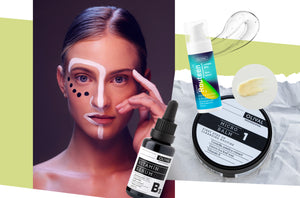Salvia hispanica , that is, chia, was once a completely exotic food, which nevertheless (and fortunately) made it to our menus and meals. It owes its popularity to the richness of omega 3 fatty acids, which the body must provide with a healthy diet. But chia is slowly but surely entering the skin care door, straight into cosmetic bags and cabinets. Omega fatty acids, namely, have been proven to provide exceptional benefits to the skin.
Of these 11, only two are essential, which means that our body cannot produce them on its own. Omega 3 and omega 6 fatty acids are primarily found in food products - chia seed oil, fish oil, walnut oil, etc.
Against redness, irritation, dryness, dehydration...
The composition of chia seed oil is very specific. It is characterized by a very high proportion of polyunsaturated fatty acids - alpha linolenic (omega 3) and linoleic (omega 6). Together they are over 80%, while the share of palmitic acid is only about 7% . [1]
We have already written about the benefits of omega fatty acids in skin care , but it is not out of place to repeat the most important information. Topical application of ingredients containing them, especially in combination with humectants and lipids, brings:
- smoother and softer skin texture
- antioxidant activity
- reduced redness, sensitivity
- reduced TEWL (transepidermal moisture loss)
- long-term strengthened skin more resistant to external influences

The most n-3 fatty acids in a plant source
In 2010, a study was conducted on the effectiveness of topical treatment of xerotic (dry) skin of patients with renal dysfunction, in which a formulation with 4% chia seed oil was applied to the skin for 8 weeks. The results showed an exceptional anti-inflammatory effect of the oil . Interestingly, it has also been declared the richest currently known plant source of omega 3 fatty acids. [2]
The study also showed that the application of chia seed oil contributed to the improvement of the barrier function of the skin (hydrolipid barrier) and the level of hydration. It reduced the itchiness and dry skin associated with the effects of kidney disease, which means it could have the same effect on other skins with similar problems. In addition to being combined with ingredients like glycerin and ceramides, chia seed oil works extremely well with other light, fast-absorbing oils.
Oils can reduce oiliness of the skin and the appearance of acne
On the other hand, it is known that oils with high proportions of alpha linolenic and linoleic acids (chia seed oil, but also blackberry, flax, hemp, evening primrose, avocado) are extremely useful and effective in the care of oily, mixed and generally problematic skin prone to comedones and inflammatory processes. So called. "oil free" products are often not the most adequate answer to the appearance of acne, and studies have shown that the solution lies precisely in oils. Namely, in problematic skins, a chronic lack of essential fatty acids and a different composition of sebum compared to balanced skin is observed, which favors hyperkeratinization, the proliferation of C. Acnes and the development of inflammation.
It was the topical supplementation of the skin with omega 3 and omega 6 fatty acids that showed a drastic improvement in skin texture without the development of new acne. [3] In addition, oils rich in polyunsaturated acids also improve the process of desquamation (removal of dead skin cells), free the pores of accumulated sebum and thus prevent fertile ground for the development of further irregularities. No less important, due to their properties, they have a lighter texture, are absorbed faster and do not leave an impression of weight on the face. Of course, every skin is different, so the effect of an individual ingredient depends on its condition, but also on the current care routine and other factors, which is why it is good to consult a dermatologist and ask for advice in the form of a personalized care routine .
Omega Elixir , a product rich in omega 3 and omega 6 fatty acids, stands out as an outstanding option of the oil complex. It is a combination of chia seed oil with squalane derived from olive (related to natural skin fat), blackberry seed oil, avocado and evening primrose. Precisely because of the specifically formulated composition, this oil is suitable for the care and nourishment of a wide range of skins, and it can be adapted to current needs with various methods of application.
------------------
[1] Yingbin Shen, Liyou Zheng, Jun Jin, Xiaojing Li, Junning Fu, Mingzhong Wang, Yifu Guan, and Xun Song. Phytochemical and Biological Characteristics of Mexican Chia Seed Oil. Molecules. 2018 Dec; 23(12): 3219. https://www.ncbi.nlm.nih.gov/pmc/articles/PMC2883415/#B6 accessed 7/23/2020.
[2] Se Kyoo Jeong, Ph.D., Hyun Jung Park, Ph.D., Byeong Deog Park, Ph.D., and Il-Hwan Kim, MD Effectiveness of Topical Chia Seed Oil on Pruritus of End-stage Renal Disease (ESRD) Patients and Healthy Volunteers. Ann Dermatol. 2010 May; 22(2): 143–148. https://www.ncbi.nlm.nih.gov/pmc/articles/PMC2883415/#B6 accessed 7/23/2020.
[3] Linder, Jennifer. Role of Oils in the Topical Treatment of Acne. Cosmetic Dermatology®. April 2008; Vol. 21 No. 4: 211 – 214. https://mdedge-files-live.s3.us-east-2.amazonaws.com/files/s3fs-public/Document/September-2017/021040211.pdf accessed 7/23/2020.






